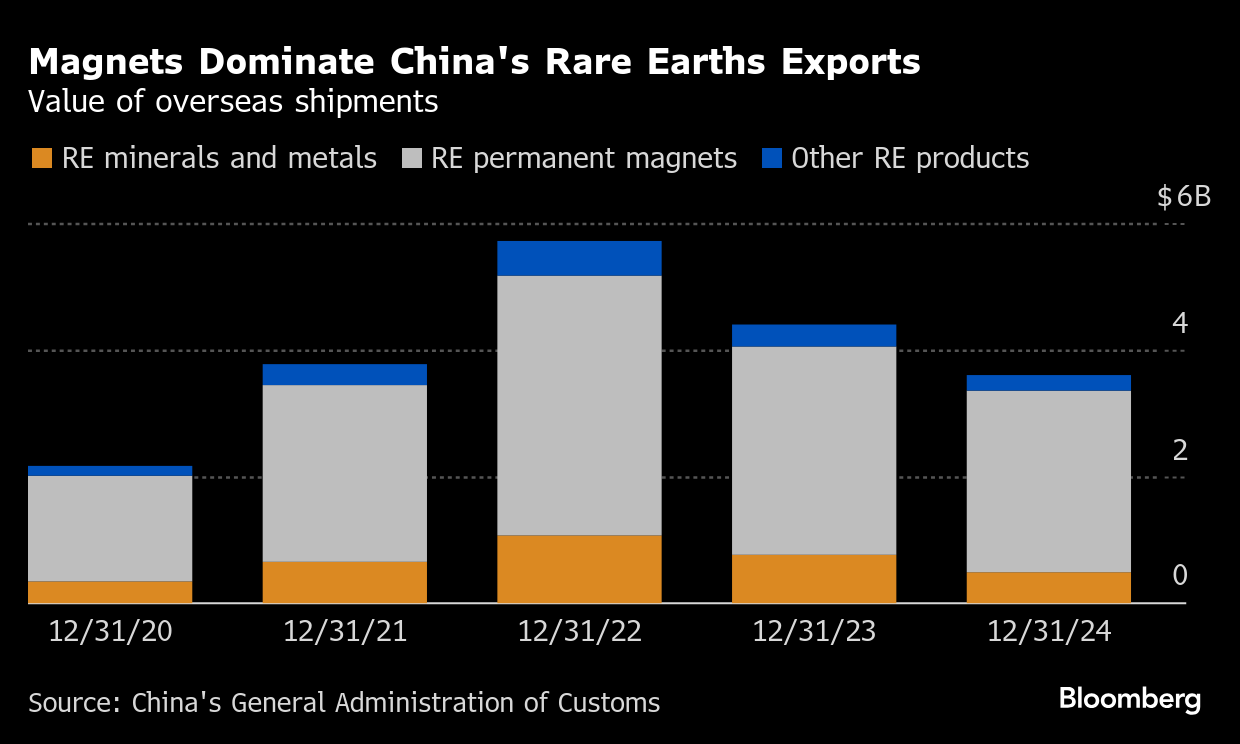China’s Rare Earth Exports Recover Ahead of US Trade Talks
(Bloomberg) -- Chinese exports of rare earths, a group of 17 minerals at the center of a trade dispute with Washington, rose 23% in May from the previous month, according to customs data on Monday.
The shipments of 5,865 tons were still below last year’s level, although the jump last month helped push the year-to-date figure 2.3% higher to 24,827 tons. The data doesn’t cover rare earth products, which include high-value magnets for electric motors and hard-disk drives.
Rare earths will top the agenda later in the day, when negotiators meet in London as the world’s two biggest economies seek to defuse tensions. The list of grievances includes China’s export controls on rare earth minerals and magnets, which are used widely in high-tech and defense manufacturing.
The customs figures on Monday offer an incomplete picture of the impact of China’s curbs, which only apply to worldwide sales of seven of the elements. Those were imposed April 4 in retaliation to punitive tariffs levied on Chinese goods by President Donald Trump. China accounts for almost 70% of the world’s production of rare earths.
The May data for rare earth products is due to be released on June 18. The breakdown of export destinations should be available June 20.

China appeared to loosen its curbs last month, after an announcement on May 12 that the two countries had agreed to lower tariffs and other barriers to trade. The US subsequently accused Beijing of stalling on sales, although delays may have been due to long lead times in China’s permitting system. European trade officials and carmakers have also sounded the alarm on disruption to supplies from China.
On Saturday, the Chinese government said it had granted approvals for some rare earth exports, without specifying which countries or industries were covered, in a move that could help smooth Monday’s talks with the US.
Customs data for April showed rare earth and product sales to the US dropping 37% from March to about 1,700 tons. Within that, rare earth magnet sales fell more steeply by 58% to 246 tons. Magnet sales to the whole world were 51% lower at around 2,600 tons.
Other commodities and energy highlights from the May trade data:
- Crude oil imports fell 3% from April to 46.6 million tons. Refineries have closed units for seasonal maintenance, affecting over 100 million tons of capacity during May, according to Mysteel OilChem
- Coal purchases dropped 4.7% to 36 million tons. The market remains heavily oversupplied given strong domestic production, relatively weak industrial demand and clean energy’s increasing penetration. Natural gas shipments, however, climbed back above 10 million tons for the first time since January. Still, imports of both power fuels continue to lag last year’s pace
- Metals imports also weakened due to the impact of tariffs on the economy. Unwrought copper and products fell 2.9%, while copper ore plunged 18% from April’s record. Iron ore for steelmaking dropped below 100 million tons
- However, metals exports remained firm as shippers front-loaded sales in case trade conditions worsened, with steel hitting a seven-month high and aluminum a six-month high
- Soybean imports, meanwhile, soared to a record of nearly 14 million tons, more than double April’s tally, as China scooped up shipments from Brazil to secure supplies amid its trade war with the US.
On the Wire
The unrelenting expansion of Chinese copper processing capacity over the past few years has now become a global headache, as smelters scramble to secure the ore they need to produce the vital industrial metal.
Chinese exports rose less than expected last month as the worst drop in shipments to the US in more than five years counteracted strong demand from other markets.
China’s consumer deflation extended into a fourth month, as price wars intensified while a spending boost during two national holidays failed to offset the drag from weak domestic demand.
Slow execution of the budget dragged on China’s growth early in the year in 2023 and 2024, according to Bloomberg Economics. This year is different — spending is flowing faster as local governments step up.
China’s central bank expanded its gold reserves for a seventh straight month in May, furthering its bid to diversify holdings despite ongoing price fluctuations.
This Week’s Diary
(All times Beijing)
Monday, June 9:
- China’s inflation data for May, 09:30
- China’s May trade balance and 1st batch of trade data, ~11:00
- Crude oil, natural gas & coal imports; oil products imports & exports
- Iron ore, copper & steel imports; steel, aluminum & rare earth exports
- Soybean, edible oil, rubber and meat imports; fertilizer exports
- China to release May aggregate finance & money supply data by June 15
- China-Brazil solar conference in Shanghai
- Shanghai Platinum Week, day 3
Tuesday, June 10:
- SNEC PV+ solar and smart energy conference & exhibition in Shanghai, day 1
- Coaltrans China in Beijing, day 1
- Shanghai Platinum Week, day 4
Wednesday, June 11:
- SNEC PV+ solar and smart energy conference & exhibition in Shanghai, day 2
- Coaltrans China in Beijing, day 2
- CCTD’s weekly online briefing on Chinese coal, 15:00
- CSIA’s weekly polysilicon price assessment
Thursday, June 12:
- SNEC PV+ solar and smart energy conference & exhibition in Shanghai, day 3
- Coaltrans China in Beijing, day 3
- China’s monthly CASDE crop supply-demand report
- CSIA’s weekly solar wafer price assessment
- EARNINGS: Chow Tai Fook
Friday, June 13:
- SNEC PV+ solar and smart energy conference & exhibition in Shanghai, day 4
- China’s weekly iron ore port stockpiles
- Shanghai exchange weekly commodities inventory, ~15:30
(Updates with additional customs data from the ninth paragraph)
©2025 Bloomberg L.P.





